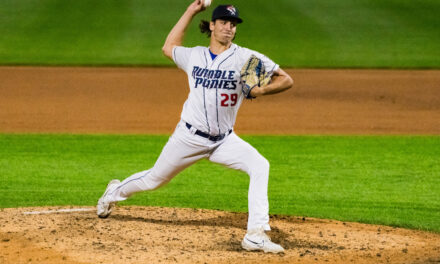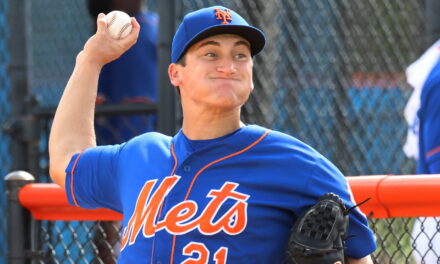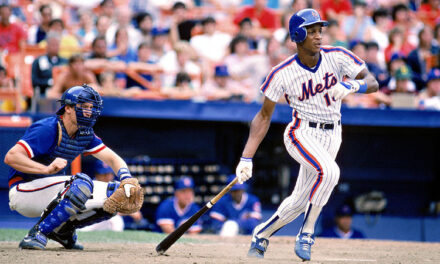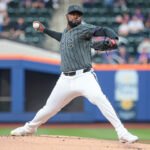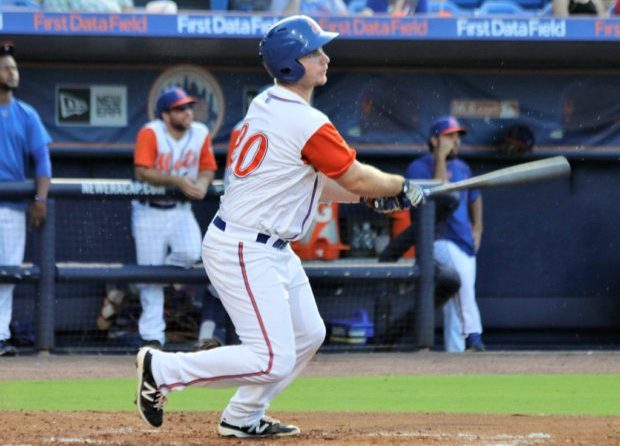
When the New York Mets selected first baseman Peter Alonso out of the University of Florida in the second round of the 2016 MLB Draft, scouts were intrigued with his raw, plus power at the plate.
In just 30 games with the Brooklyn Cyclones last year, before he was sidelined the rest of the season due to a broken right pinky finger, Alonso hit five home runs, 12 doubles and a triple in just 109 at-bats.
Heading into 2017, Alonso was looking to make a name for himself within the organization. With Lucas Duda entering his final year of team control before free agency, and the team’s top first base prospect, Dominic Smith, seemingly waiting in the wings, Alonso offered the team another possible option at the position or as a potential trade chip.
He opened the ’17 season in St. Lucie, where he got off to a rocky start. He was batting just .190 through his first five games before being hit on the same hand that he injured just a year prior, as he was helping to lead the Florida Gators to the College World Series. This time, Alonso would miss the next six weeks of the High-A season, remaining inactive for five-plus weeks before starting baseball activity in extended spring training.
Upon his return, the six-foot-three slugging first baseman needed to find his timing and get his rhythm back at the plate. Batting .143 with just two home runs and 21 strikeouts through June 12, Alonso was growing frustrated seeing his average and power numbers continue to slide.
Working with manager Chad Kreuter and hitting coach Luis Natera, Alonso worked tirelessly on drills, including tee work to help match his bat angle with the ball.
A tale of two seasons, Alonso saw his pedestrian numbers balloon to the power potential scouts were impressed by, posting a .325/.396/.590 slash line from June 13 on, with 16 home runs, 25 doubles and 57 RBIs in 74 games with St. Lucie and Binghamton (promoted August 24).
At the completion of the season, Alonso was tied for second in the Florida State League in home runs (16), and finished second among all Mets minor leaguers in home runs (18), 7th in RBIs (63) and 7th in OPS (.883) with a minimum of 200 plate appearances. Not bad for a guy who missed six weeks between April and May and had to regain his timing again the plate.
With the aforementioned promotion to Binghamton at the end of August, Alonso got to experience the postseason, as the Rumble Ponies finished 31 games above .500 and faced the Trenton Thunder in the Eastern Division Championship Series. The Rumble Ponies fell three games to one in the best of five series, though, Alonso hit a robust .429 (6-for-14) with two doubles and four RBIs acting as the DH.
I had the privilege of speaking with Alonso prior to the start of the ’17 season, which you can read here, and had the opportunity to speak with the rising first base prospect again last week, where we discussed his season, adjustments he made at the plate, and if anyone in the organization as broached the subject of switching positions.
MMO: Talk to me about your first spring training this season with the Mets. What was that experience like for you?
Peter: I thought it was awesome being able to see everyone. I got a small, little taste of that at instructional league the year before, but it was really cool being able to see everyone and realize how big the whole Mets project is. I’m putting it that way because it’s this whole developmental program, just so many different guys just trying to make the big leagues.
It was cool seeing everybody and seeing new faces and seeing some familiar faces from the season and instructs. I thought it was a great experience.
I was lucky enough to go up to the big league side for, I think, five games or so and got some really, really good exposure. I got to meet a lot of great guys up there and got to meet basically everybody. The Mets have an incredible staff and I just thought it was a really positive experience before the season.
MMO: When you were up with the big club in spring, did you get to interact and pick the brains of some of the top veterans?
Peter: I did. I was kind of sad, selfishly, when [Curtis] Granderson went because he’s an incredible, incredible guy. It was awesome being able to get to talk to him and Jay Bruce, he was a classy guy and he’s fantastic. That big league team had a mixture of young and older guys so I got a chance to talk to [Michael] Conforto a little bit.
I was really fortunate enough that when guys got hurt, St. Lucie was their rehab stop for most. I got to talk to [Brandon] Nimmo, Lucas Duda, [Asdrubal] Cabrera, [Juan] Lagares, [Wilmer] Flores; the list goes on and on. It’s not a good thing that they’re on rehab, but, I got to talk to a lot of the guys and they were really, really great guys and I was really thankful.
I had a lengthy talk with Lucas, and I asked him a bunch of questions that I was curious about and he gave me as much of an outline as I could have. [He told me to] be mentally tough and don’t let anyone let you falter. Get your work in and when you’re up there play like the star of the show. Keep working every day, get better and keep yourself grounded and focused on just playing and being a good teammate. It’s kind of the expected answer but it can’t be more true because there are guys that don’t help each other out that aren’t good teammates. So he was just reinforcing that and concentrating on yourself and getting better.
Cabrera’s another guy. He came down for the series in Daytona, and he was really helpful. Especially watching him take ground balls, because he’s silky smooth and watching him pick and see what he’s doing. There’s been a lot of guys that were extremely helpful and open-minded.
MMO: So, you’re the type of guy that has no qualms about going up and picking player’s brains and asking questions?
Peter: Yeah, I’m not going to talk just to talk. But if I’m curious, I’m going to ask. Or, if I want to ask them about their experiences and take anything from it, of course!
That helps me get to know them and them get to know me a little bit. I don’t want to be that guy that doesn’t say anything or is in the corner. Usually, if I have something to say, I mean it. It’s genuine and I want to have a conversation or I’m curious about it.
MMO: You sustained an injury early on in the year, getting hit on your hand for the second time in two years. How frustrating was that for you to be out for six weeks early in the season?
Peter: I was extremely, extremely frustrated the first week. The second week I came to terms with it and also halfway into the third week. But then after that two and a half-three week mark, I started to go insane. I wanted to play so bad! I was itching and it was tough because I wanted to be out there and people kept telling me it’s only six weeks. I know it’s only six weeks but that’s still a long time!
It was extremely frustrating. I did everything I could to try and stay fresh and locked in during the games like trying to pick pitches on the bench, be a good teammate and let people know if they’re doing anything [wrong] that I see. Just trying to be the best teammate and help that I could be even though I’m not playing.
I thought I did a pretty good job of that, but it was tough sitting. Once I went down to extended to get my at-bats, I was just so happy because then I finally got to do baseball activities and start the actual playing before I got back [to St. Lucie], which was the best part of the rehab and recovery.
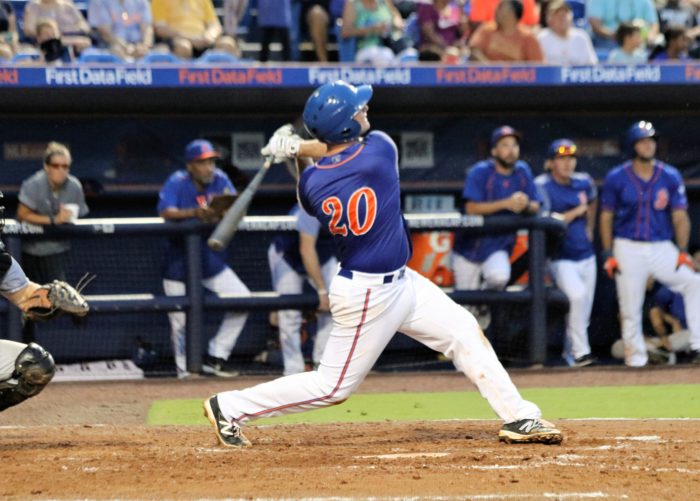
MMO: When you came back at the end of May until about the middle of June you hit a bit of a slide, and then all of a sudden you just went on a tear. In 74 games from June 13 to the end of the year you hit 16 HR, 25 doubles, drove in 57 and had a .325 average. What do you attribute your turn around to?
Peter: It was a combination of things. I know I had a short little stint at extended [spring], but it’s a huge difference between playing in extended than playing games that matter, that count towards your season. Also, it was after being inactive for so long, it’s like spring training doesn’t matter. Your timing goes away and the game speed is a little different. I’m not trying to knock extended by any means, it’s just different. Playing a live season game, that took some time.
The Florida State League is a really talented league which was a tough adjustment. I’m not saying I was Babe Ruth before I got hurt the five games [prior to the injury], but I struggled, and it was a tough adjustment.
The Florida State League is known for guys that throw really hard, I don’t know why but that’s the MO. Being a fastball hitter, that’s the frustrating and mentally taxing part; I would get my fastball and then miss. I would try and do too much, I was thinking way too much and also I needed to keep working and get my timing perfect.
It was long and it was a struggle and I worked with my manager, Chad Kreuter, and my hitting coach, Luis Natera, tirelessly. They showed me some drills, we developed a plan and it was a day-by-day grind, it was a process. Over that three weeks, I was hitting .150 or so, and every time you go to the plate and take a glance up at the board and see that you’re hitting .150 on the year is just embarrassing.
After that point everyone’s capable of finding something in themselves, I’m a firm believer in that. It’s like, I’m tired of sucking and I’m going to turn this ship around. I’m going to come out swinging like a gang-buster every single day. Just keep going and then see where I end up at the end of the season.
I kept hitting and it was like, All right, if you keep hitting you’re going to have an okay year. Every week or week and a half it would raise ten points and it was like, holy shit, this is getting there! This would be a hell of a salvage year, just keep salvaging.
I didn’t give up at-bats. All of my at-bats were, for the most part, extremely competitive and was focusing on being locked in every single pitch. That’s tough to do and I’m really proud of myself for fighting and getting myself out of the hole and turning it into a hell of a season for the circumstances.
MMO: Were there any mechanical adjustments made when you were trying to right your season?
Peter: It’s not necessarily changing my swing, it’s starting my hands just a tad lower and shortening my base a little bit.
I mentioned before I worked on a couple of drills. One was a contact drill, and just a couple of tee drills to help match my bat angle to the ball, and timing and rhythm. I know it’s ridiculous to think a tee drill could help with your timing and rhythm, but I was thankful enough to have incredible knowledge from my hitting coach and my manager.
Luis’s been coaching for a long while; he’s helped with developing so many players. Kreuter’s been coaching for a while now and he played fifteen years in the big leagues, so that’s an incredible amount of knowledge. I went to those guys and they helped. If I took eight swings in the cage and everything was perfect they’d kick me out and tell me to get out of the cage, take it into the game and remember that.
I’m very pleased with how they were and helping me develop along the season. Both of their doors were always open whenever I needed to talk, and they were always there to listen and help me improve. Without those two, it would’ve been very tough to get better.
MMO: I noticed looking at your spray charts you were going the opposite way a lot more than you did with Brooklyn, especially while you were with St. Lucie. Was that something you were working on? To use the whole field more?
Peter: Yes, but also people got smart, and didn’t throw me in. [Laughs.] I remember my first game back, it was against the Thrashers, and it was off of someone throwing 94 plus. He beat me on fastballs my first at-bat, and I’m like, All right, whatever. Then fastball in, BANG, I crush it. After that, clearly don’t throw this kid fastballs in.
It turned into learning to take pitches that weren’t strikes, and after that it was just take what they give you. That was kind of the MO this year, after you do damage you have to take what they give you, take your hits to the right side.
In the Penn League last year, I felt that they could pitch in, anybody could throw in, but I was pitched in a fair amount in the Penn League. There’s a lot of talent in the Florida State League regarding arms, I was very impressed. All of us would joke around that no major league staff throws this hard.
When [Yoenis] Cespedes came down and was hitting against the Flying Tigers, we had a game with some guy throwing 96-98 through the start, and then a guy from the pen throwing just as hard. They had three or four guys throwing 97, touching 100 mph. He was like, “You’re not going to see this in the big leagues, this consistent velocity. You’re going to see guys who can sink it 92-94, hit spots, play mind games and not just going to be with the consistent blow you away stuff. Instead of throwing 96-97, they’re just going to sink it at 93 and in their spot.”
I’d rather have the 96-98 but when I was struggling I’m like, I can’t believe this. Cespedes is telling us that velo wise this is not realistic in the big leagues. What’s going on here?
MMO: It must’ve given you an extra boost of confidence then that you were able to excel in that league?
Peter: Kreuter told me if you can be successful in this league you can compete and play at the big league level, which I’m a firm believer in.
MMO: You got to play with Tim Tebow this year in St. Lucie, and also you both share the same alma mater with the University of Florida. What kind of guy is Tebow and what were some of your thoughts on him this season?
Peter: I got to play with him in instructional league before spring training and obviously before he came to St. Lucie. That was good that I got to play with him then and get some familiar time with him. He’s a nice guy, good teammate; he’s about as normal as Tim Tebow can be. I know he has a huge following, not just for college football or for the NFL people, but for his Christian following, it’s huge.
There’s a large amount of people that like him and that are huge fans and obviously it showed coming out to the games because most of our games were packed. It was cool because it’s really, really hard to play and get pumped up for a game when there’s like 50 people and there’s a stadium of 12,000 capacity. If someone farts on the field fans would be able to hear it. [Laughs.] When you see people coming in the stands it’s nice. It’s fun! Even though some of them may not know baseball all that well it’s still fun for people to be there and cheer.
It was extremely uplifting, I think, for fans to be there, and I appreciated that. I thought it was a blast.
MMO: Getting called up to Binghamton, what were some of the major differences between the Florida State League and the Eastern League?
Peter: There’s a lot of right-handed pitchers in the Eastern League. In the Florida State League, it’s fastball/slider, but you have a lot of guys up here that can throw a third and fourth pitch for a strike. They can throw a right-on-right changeup, they can throw a cutter, slider or a curveball. You start to see some splitters up here.
The pitchers try to manipulate the ball a little more as opposed to beating you with a fastball.
MMO: What was Binghamton’s playoff run like?
Peter: The first couple of days up there, I find out that they’re going to clinch a playoff spot. Then a couple of days in we do the champagne shower in the locker room, which I thought was a blast. I came up at the perfect time; I think we won seven or eight in a row going into the playoffs. I had a blast playing with those guys, it was a fantastic group of guys.
The playoffs were fun. It didn’t go the way we wanted to, but that’s baseball. I know I was only up there for a little amount of time in the season, but when [Manager] Luis Rojas called everyone in at the end of the year and said, “You guys finished 31 games above .500 this year. In pro baseball that’s hard to do. You guys had a hell of a year.”
It was sad because we were a good team and if things went a little bit differently then of course we could’ve won. It was frustrating because we lost, no one wants to lose. It’s a part of it and we just have to go get better next year and come into spring training ready to go, ready to win.
It was fun, I couldn’t be happier with my time up there. What made it extremely special was all the guys up there, everyone was super welcoming and I’m just happy that I got a chance to go up and experience that.
MMO: With the Mets dealing Duda prior to the trade deadline and calling up Dominic Smith, has anyone in the organization spoken to you about a possible position change going forward?
Peter: No, they haven’t made me aware of switching positions or anything. Right now, I’m just going to try and become the best first baseman I can be and just play as hard as I can every day.
MMO: Heading into the offseason, what are you looking to do in order to be prepared for next season?
Peter: I’m going to get in the best shape of my life. Hopefully, I come into spring training looking sharp and ready to go. I want to show up in the best shape of my life, open some eyes in that aspect, hit the ground running and just get in good form as quickly as possible. I want to be able to have a fully healthy year and open some eyes.
MMO: Thanks so much for your time, Pete. Enjoy the offseason and wishing you all the best in 2018!
Peter: Thank you, I appreciate it.
Follow Peter on Twitter, @PeterAlonso20


